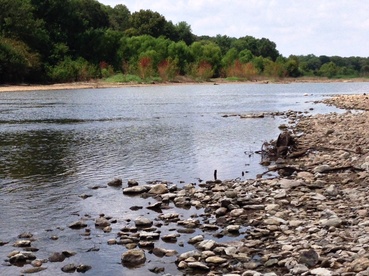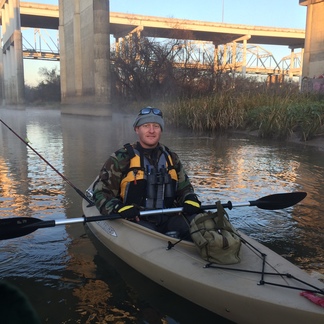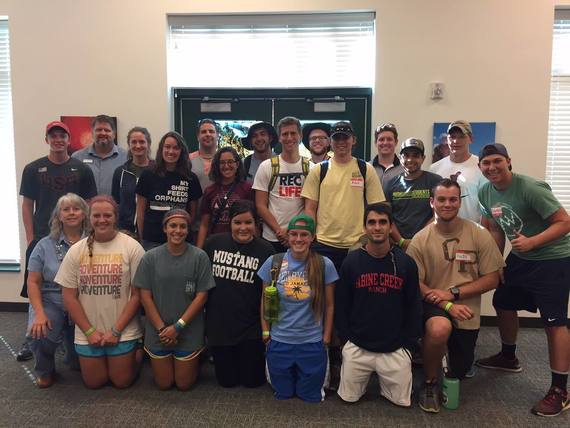|
In This Issue:
by Caleb Harris, Aquatic Training Specialist - Central Texas
 Ever try to plan a paddling trip on a Texas river? Ever look at a Texas map and wonder how you could get to a fishing spot on one of the long winding rivers? Have you come across the blunt fact that there is very little public access to long stretches of Texas rivers?
Texas Parks and Wildlife (TPWD) is trying a unique approach to create additional public river access for fishing on Texas rivers. TPWD has temporary contracts with private land owners to lease their river bank property for limited public access and use. Currently TPWD has two sites on the Brazos and Colorado rivers, and one site on the Neches rivers. The Guadalupe river also has winter trout sites. After the initial trial period, TPWD hopes to expand the program to additional sites on stretches of rivers where there is no public access.
Landowners can negotiate specific terms of their lease access, and the terms may vary from site to site. Make sure you know the specific site rules and policies before you go, check:
- the registration process
- access fees
- maximum number of people per day
- driving and parking info
- pet, camping or fires policies
- restroom and water availability
Program funding is provided by the Texas Parks and Wildlife Foundation and the U.S. Dept. of Agriculture’s Voluntary Public Access and Habitat Incentive Program. These sites are different from paddling trails as they are not necessarily leased for paddlers, but for anglers. Fishing is the primary goal of the lease program, though people may also use them as put in and take outs. Paddling trails are all public land access to rivers and are good fishing trails too.
Most landowners are happy to participate in the program, but are leery of being taken advantage of by disrespectful and unethical participants.
TPWD encourages quiet and ethical use of these properties as they are still private lands. If people misuse them, the land owner may be inclined to back out of the program, and others will lose access to these rivers again. Things to keep in mind:
- keep groups small and noise levels low
- drive and park in designated areas only
- respect wildlife and property
- practice “leave no trace” and leave it looking better than you found it by picking up the area
- follow all game laws and fishing regulations
Finally, if a landowner happens to be there, make sure and thank them.
We are excited to see the River Access Program expand and get some anglers onto these hard to reach sections of our rivers. Get out and visit one on your next fishing trip!
|
Back to Top
by Greg Akins, Aquatic Training Specialist - Houston

During the winter months, many anglers enjoy going fishing for rainbow
trout or speckled trout. Both, our angling community and our Aquatic Education
Instructors, should be mindful of cold weather conditions while fishing on
land or on the water, and include safety tips when teaching.
Typically, anglers prepare to get on the water, but don’t prepare to be
in it. Wouldn’t it be great if everyone thought about “What if” every time they headed out? What if a storm or cold front blows in while I’m fishing? What if I
fall in the water? What if… This time of year, thinking about hypothermia is
key, whether fishing from the bank, pier, kayak or boat.
Hypothermia can occur on land or in water. The majority of deaths in
cold water are due to hypothermia. Immersion in cold water (65° F or colder) will cause panic and rapid
breathing, loss of the body’s core temperature, and affects your brain, heart,
lungs, muscles and nerves, resulting in an inability to swim or move.
How can you prevent hypothermia? Check the weather report and water
conditions, and consider cancelling the trip if necessary. If you do decide to
go out, be prepared. Dress appropriately in layers: wear a base “wicking” layer,
a warm “insulating” layer, and a wind layer. Finally, wear a lifejacket. Don’t
forget to also wear a warm hat, gloves and socks.
Appropriate clothing such as synthetic and wool fabrics are superior to
cotton in the winter because they provide better insulation when wet and dry.
Consider packing a towel, blanket and an extra set of dry clothes in your car
or in a dry bag on the boat. Wearing a life jacket not only prevents drowning,
but in cases where there are cold water temperatures, wearing it will increase
your chances of survival.
Know the signs of hypothermia and what to do:
-
Mild hypothermia – person is shivering but coherent – move
them to a warm place, remove wet clothing and have them drink warm (not hot)
drinks (no alcohol or caffeine.)
-
Moderate hypothermia – person may be irrational and shivering
may stop – move them to a warm place and seek immediate medical attention.
Do not give them anything to drink.
-
Severe hypothermia – person may be semiconscious or
unconscious. Lay them down on their back, cover torso, thighs, head and neck
for warmth. Do not stimulate arms and legs to prevent cardiac arrest. Do not
give them anything to drink. Seek immediate medical attention. If
unconscious, do not give CPR – it could cause cardiac arrest.
Teach about hypothermia:
In your Angler Instructor workshop
or fishing class safety section, include information about being prepared for
the weather (hot or cold.) Teach the signs of hypothermia, and the 1-10-1 principle
if immersed in cold water:
- Within 1 minute
get control of your breathing.
- You
may only have 10 minutes of meaningful movement (being able to swim.)
- You
may only have 1 hour before you become
unconscious while wearing a lifejacket.
Watch or share this National
Water Safety Congress video to learn about the 1-10-1 principle.
Use a hands-on activity in
your classes with adults or youth: fill a 2 to 5 gallon bucket with ice water.
Drop in several pennies, then have the students immerse one hand into the
bucket for 2 to 5 minutes. Next try to have them pick up the pennies. Ask them to
explain what happened and what they experienced. Lesson extensions might include
several buckets of water with varying temperatures (warm, cold, freezing)
timing each student while they attempt to pick up the pennies.
In the future, let’s
remember that any kind of participation in and around
water, including accidental entry, can increase the possibility of hypothermia. The “what if” factor can make the difference between a bad or good fishing trip.
|
Back to Top
by Karen Marks, Aquatic Education Manager
As we cast into the New Year, I wanted to take a moment and reflect upon your accomplishments for 2015 -- it was an outstanding year! Many of you were very busy teaching fishing! A total of 17,546 volunteer hours were reported, and with your help, our program reached 40,343 youth and 28,684 adults. By now all of our active volunteers should have received a small token of appreciation in the mail.
Of course a new year also brings new state laws and program policies. In response to the state’s new open carry law, TPWD has adopted a new policy that applies to all employees and volunteers. The policy was sent out via email to all TPWD volunteers.
Some of our reporting policies have also changed due to our recent federal grant audit. These new policies went into effect on January 1, 2016 and are posted on the Angler Education Instructor Resources web page; they were also sent out via email, and with the incentive packages. The two biggest changes are:
- all hours must be documented by day (no lump sum hours may be reported)
- volunteers must self-report their time (if they are not utilizing the online reporting form, then they must individually sign and write down their hours on the paper roster form—the event coordinator cannot write in the hours for the volunteers.)
We also have updated our Instructor Resource web page with several new teaching aids, lessons and other helpful PowerPoints and videos. Be sure to check out and use:
- Calendar Fishing Chart
- Aquatic Invasive Species Card and PowerPoint
- Common Texas Sunfish ID Card
- “Test Your Fish IQ” PowerPoint and handouts
The "Where to Fish" brochures, now called "Easy Access Fishing Spots" for Austin, San Antonio, Houston and Dallas/Fort Worth have been updated too.
Save the date if you are interested in taking the next step to train other adults as TPWD Angler Education Instructors. Our annual Area Chief training and meeting will be held in Austin on April 1st – 2nd ….No Fooling! Contact Karen Marks for more information.
Happy New Year!
Back to Top
by Natalie Goldstrohm, TPWD Inland Fisheries Biologist - Abilene

As a biologist working for Texas Parks and Wildlife Department (TPWD)
and a certified Angler Education Instructor, I have the opportunity to
introduce fishing to diverse groups of people. Recently, I was approached by
Services for the Blind and Visually Impaired to conduct a fishing event with
their youth. Once we agreed on an event date, we developed a curriculum
based on the abilities and fishing experience of our participants.
Since many of the TPWD Angler Education activities we use at outreach
events are hands-on, they were perfect for this group. When teaching the
activities, our team focused on how other senses, besides vision, could be used
to teach youth about fish and their environment. Our outreach kits come
with textured plastic fish so the children could feel their scales. We also
used life-sized catfish created with a 3D printer so the children could
practice proper fish handling and learn the parts of the fish. Noting that
catfish also have poor eyesight, the catfish models were very useful to show
the students how these fish use their barbels and sense of smell to find food,
and their lateral line to detect vibrations.
We transitioned to teaching what equipment anglers can use to catch
fish. The youth learned about traditional fishing rods, lures, and baits. We
also passed around rattle-traps so the youth could hear the sounds they make
and feel the vibrations that attract fish.
Once the youth knew the best way to trick a fish into biting their
line, we practiced casting with the Backyard Bass activity. Next, we were off
to the lake for real fishing. All poles had bobbers, but most of the youth
kept a finger on their line to feel if a fish was nibbling their bait. Most of them felt the fish pick up their bait and were able to reel them into shore.
Given
that this was our first venture with this group, we were unsure of how the
event would fare, but the youth and their families really enjoyed learning about fishing.
|
Back to Top
Welcome
to our new Instructors! Our staff and Area Chiefs have trained 240 new
instructors in the past six months.
In April 2016, Hutsell
Elementary will be celebrating their 10th anniversary fishing event. Check out
the history of this successful school program (PDF).
Alumni parents and students are encouraged to attend, please contact Dr. Margie
Blount to share your memories or for more information about the event, MargieBlount@katyisd.org
or (281) 237-6506
Dallas
Ecological Foundation (DEF) announced their Outdoor Education Teacher of the
Year, Coach Lloyd Love with Pasadena ISD. Watch the inspiring video to see how he incorporates Angler
Education into his high school classes.
 Image: Students from Dallas Baptist University earned their Angler Education Instructor certification at Texas Freshwater Fisheries Center
Back to Top
Back to Top
Back to Top

|